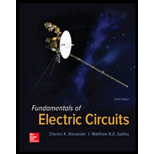
Concept explainers
(a)
Find the Fourier transform of
(a)
Answer to Problem 24P
The Fourier transform of
Explanation of Solution
Given data:
Formula used:
Consider the general form of Fourier transform of
Calculation:
Apply Fourier transform to equation (1) as follows.
Substitute
Conclusion:
Thus, the Fourier transform of
(b)
Find the Fourier transform of
(b)
Answer to Problem 24P
The Fourier transform of
Explanation of Solution
Given data:
Calculation:
Apply Fourier transform to equation (2) as follows.
Substitute
Conclusion:
Thus, the Fourier transform of
(c)
Find the Fourier transform of
(c)
Answer to Problem 24P
The Fourier transform of
Explanation of Solution
Given data:
Calculation:
Apply Fourier transform to equation (3) as follows.
Substitute
Conclusion:
Thus, the Fourier transform of
(d)
Find the Fourier transform of
(d)
Answer to Problem 24P
The Fourier transform of
Explanation of Solution
Given data:
Calculation:
Apply Fourier transform to equation (4) as follows.
Simplify the equation as follows.
Substitute
Conclusion:
Thus, the Fourier transform of
Want to see more full solutions like this?
Chapter 18 Solutions
Fundamentals of Electric Circuits
- Regarding Signals and Systems, given a signal x(t) = |cos(ωt)| for ω>0. Find the Fourier transform of x(t). Please do not ignore the absolute value operator (that is what I am struggling with.arrow_forwardThe Fourier transform of a continuous-time signal x(t) is denoted by X(ω). Apply CTFT properties to obtain the Fourier Transform of x(3t+7).arrow_forwardBe able to calculate the Fourier transform of a function Find the Fourier transform of each function. In each case, a is a positive real constant.f(t)=0,t<0,f(t)=e−atsin ω0t,t≥0.arrow_forward
- give the Fourier transform of the signal x(t) = -1 for -2≤t≤0 = 5 for 0≤t≤2arrow_forwardThe Fourier transform of the signal is real (real) as X (jw) = 2a / (a² + w²) as previously found. It has no complex part. What is the reason of this?arrow_forwardShow that the Fourier Transform of the Fourier Transform, F{F{f(x)}}, and the Inverse transform of the Fourier transform, F -1 {F(k)}, are not equal to each otherarrow_forward
- Regarding Signals and Systems, the Fourier Transformation of x(t) is given by X(jω)=F{x(t)}. The time duality property is X(jt)=2πx(-ω). My question is how do you go from x(t) to X(jt) and from x(-ω) to X(jω)? Thank you!arrow_forwardFind out the discrete time fourier transform of the signal y[n]=an u[n] where a<1.arrow_forwardf(t) = 8 e^4(t+1) cos(t − 3) Find the Fourier transform of the given function.arrow_forward
- Calculate the Fourier Transform F(?) of the function f(t) described below:f(t) = Ae-(t/T) when t > 0andf(t) = Ae+(t/T) when t < 0arrow_forwardUse the Fourier transform of tnf(t) to find each of the followingFourier transforms (assuming a>0): F{ te−at u(t) },F{ | t |e−a| t | },F(te−a| t |}.arrow_forwardConsidering the continuous sign x (t) given the Fourier transform, find the value of x (3,3) for the values a = 2 and b = 2.arrow_forward
 Introductory Circuit Analysis (13th Edition)Electrical EngineeringISBN:9780133923605Author:Robert L. BoylestadPublisher:PEARSON
Introductory Circuit Analysis (13th Edition)Electrical EngineeringISBN:9780133923605Author:Robert L. BoylestadPublisher:PEARSON Delmar's Standard Textbook Of ElectricityElectrical EngineeringISBN:9781337900348Author:Stephen L. HermanPublisher:Cengage Learning
Delmar's Standard Textbook Of ElectricityElectrical EngineeringISBN:9781337900348Author:Stephen L. HermanPublisher:Cengage Learning Programmable Logic ControllersElectrical EngineeringISBN:9780073373843Author:Frank D. PetruzellaPublisher:McGraw-Hill Education
Programmable Logic ControllersElectrical EngineeringISBN:9780073373843Author:Frank D. PetruzellaPublisher:McGraw-Hill Education Fundamentals of Electric CircuitsElectrical EngineeringISBN:9780078028229Author:Charles K Alexander, Matthew SadikuPublisher:McGraw-Hill Education
Fundamentals of Electric CircuitsElectrical EngineeringISBN:9780078028229Author:Charles K Alexander, Matthew SadikuPublisher:McGraw-Hill Education Electric Circuits. (11th Edition)Electrical EngineeringISBN:9780134746968Author:James W. Nilsson, Susan RiedelPublisher:PEARSON
Electric Circuits. (11th Edition)Electrical EngineeringISBN:9780134746968Author:James W. Nilsson, Susan RiedelPublisher:PEARSON Engineering ElectromagneticsElectrical EngineeringISBN:9780078028151Author:Hayt, William H. (william Hart), Jr, BUCK, John A.Publisher:Mcgraw-hill Education,
Engineering ElectromagneticsElectrical EngineeringISBN:9780078028151Author:Hayt, William H. (william Hart), Jr, BUCK, John A.Publisher:Mcgraw-hill Education,





